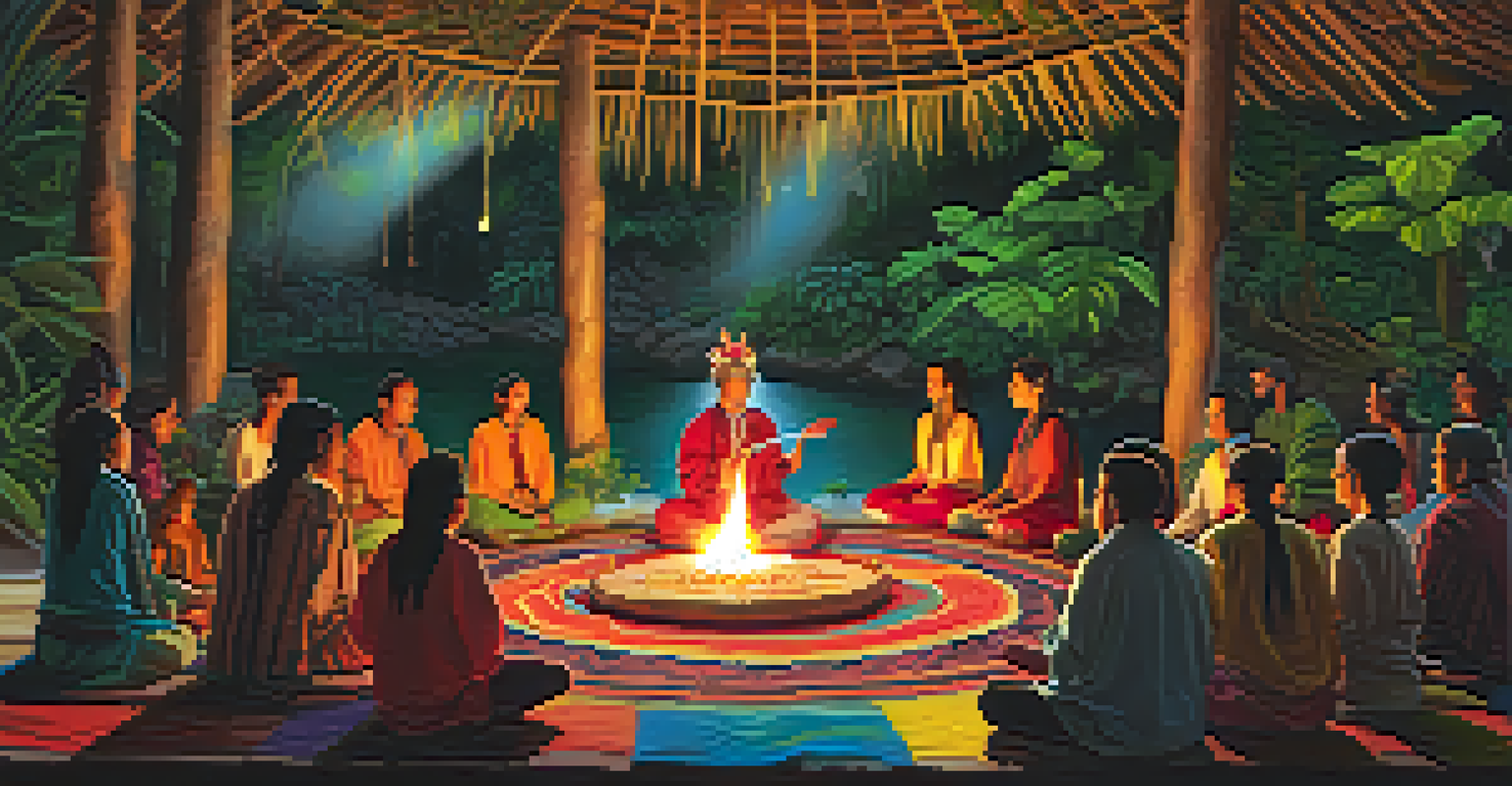Cultural Perspectives on Entheogens and Meaning-Making

Understanding Entheogens: A Cultural Overview
Entheogens are substances that many cultures use to facilitate spiritual experiences. Derived from the Greek words for 'god' and 'generate,' these compounds have long been integral to various rituals and practices. From ancient shamanic traditions to modern spiritual movements, entheogens serve as tools for exploring consciousness and connecting with the divine.
The use of entheogens is a journey of self-discovery and exploration of consciousness, allowing individuals to connect with the divine within themselves.
In many indigenous cultures, these substances are not merely recreational; they are sacred. They often act as bridges between the physical and spiritual realms, helping individuals find deeper meaning in their lives. By understanding the cultural significance of entheogens, we can appreciate their role beyond mere substances.
Exploring the diverse ways cultures have employed entheogens reveals rich tapestries of meaning-making. This understanding can inspire a broader dialogue on spirituality and consciousness, emphasizing the importance of context in these transformative experiences.
Historical Context: Entheogens Across Civilizations
Throughout history, many civilizations have incorporated entheogens into their spiritual practices. For example, the ancient Greeks used kykeon, a psychedelic beverage, in the Eleusinian Mysteries to facilitate profound mystical experiences. Similarly, indigenous tribes in the Amazon have utilized ayahuasca for centuries as a means of healing and spiritual insight.

These historical contexts illustrate that the relationship between humans and entheogens is not a modern phenomenon; it is deeply rooted in our collective past. By examining these traditions, we gain insight into how different societies have understood and integrated these experiences into their worldviews.
Entheogens: Cultural and Spiritual Tools
Entheogens have been used across cultures as sacred substances that facilitate spiritual experiences and personal insights.
As we look back on these practices, it becomes evident that entheogens have played a significant role in shaping cultural narratives. They have been instrumental in guiding individuals on their journeys toward self-discovery and understanding of the universe.
Modern Perspectives: The Resurgence of Entheogen Use
In recent years, there has been a notable resurgence in the use of entheogens, particularly within Western societies. This revival is often linked to the growing interest in mental health, spirituality, and holistic healing. Many individuals are turning to these substances as alternatives to traditional therapies, seeking deeper insights into their lives.
Entheogens provide a bridge between the sacred and the secular, offering insights that can transform our understanding of existence.
Moreover, the growing body of scientific research surrounding entheogens has contributed to their acceptance. Studies highlighting their potential therapeutic benefits for mental health issues like depression and PTSD have sparked conversations about their rightful place in contemporary society. This modernization of entheogenic practices reflects a blend of ancient wisdom and modern science.
As people seek to redefine their spiritual paths, entheogens are being integrated into various wellness practices, such as yoga and meditation. This fusion of traditional and modern approaches has led to a richer understanding of meaning-making in today’s world.
Spirituality and Personal Transformation Through Entheogens
For many, the use of entheogens is a deeply personal journey towards spiritual growth. Individuals often report profound insights, emotional healing, and a sense of interconnectedness with the universe during these experiences. This transformative potential can lead to lasting changes in perspective and behavior.
The narratives surrounding personal transformation through entheogens often highlight themes of self-discovery and acceptance. People describe feeling a sense of unity with nature and humanity, prompting a reevaluation of their life choices and values. This newfound clarity can inspire individuals to engage more meaningfully with their communities and the world.
Modern Resurgence and Acceptance
The recent revival of entheogen use in Western societies is linked to a growing interest in mental health and holistic healing.
However, it's essential to approach these experiences with respect and intention. Understanding the potential risks and benefits can empower individuals to navigate their journeys safely and responsibly, enhancing the potential for meaningful insights.
Entheogens in Rituals: Bridging the Sacred and Secular
Rituals incorporating entheogens serve as a powerful means of connecting individuals to the sacred. Many cultures have established ceremonial practices that guide participants through their experiences, creating a supportive environment for exploration. These rituals often include elements like music, chanting, and communal sharing.
The sacred nature of these practices emphasizes the importance of intention and reverence. By framing entheogen use within a ritual context, participants can foster a deeper connection to their experiences, enhancing their understanding of meaning-making. This approach contrasts with recreational use, which may lack the same depth and purpose.
As contemporary society seeks to reclaim these practices, there is a growing movement towards integrating ritualistic elements into modern entheogen experiences. This blend of old and new can enrich individuals' journeys, fostering a greater sense of community and shared understanding.
Cultural Appropriation vs. Cultural Appreciation
As interest in entheogens grows, so does the conversation about cultural appropriation versus appreciation. Many indigenous cultures have faced challenges in protecting their sacred practices from commercialization and misrepresentation. It’s crucial to approach these traditions with respect and understanding, recognizing their historical and cultural significance.
Cultural appropriation occurs when elements of one culture are adopted by another, often without acknowledgment or respect for their origins. This is particularly concerning when it comes to entheogens, as many indigenous practices are deeply rooted in spiritual beliefs and communal values. Engaging with these practices requires sensitivity and a commitment to honoring their cultural contexts.
Respecting Cultural Contexts
Engaging with entheogens requires a deep respect for their cultural origins to avoid appropriation and ensure meaningful interactions.
Conversely, cultural appreciation involves acknowledging and respecting the origins and significance of these practices. Building relationships with indigenous communities and supporting their rights can foster a positive exchange of knowledge, ensuring that the practice of using entheogens is both respectful and informed.
The Future of Entheogens: Insights and Innovations
Looking ahead, the future of entheogens seems promising, with ongoing research and increasing acceptance paving the way for new possibilities. As more studies emerge highlighting their benefits, we might see a shift in how society views these substances, from taboo to therapeutic. This change could encourage more open conversations about spirituality and the human experience.
Innovations in the field of entheogenic research may lead to novel applications, such as tailored therapeutic approaches that combine traditional practices with modern psychology. By integrating various perspectives, we can create a more holistic understanding of how entheogens can contribute to mental health and personal growth.

Ultimately, the future of entheogens lies in our ability to balance respect for their cultural origins with the potential for personal and societal transformation. By fostering a dialogue that values both ancient wisdom and contemporary insights, we can navigate this fascinating landscape responsibly.